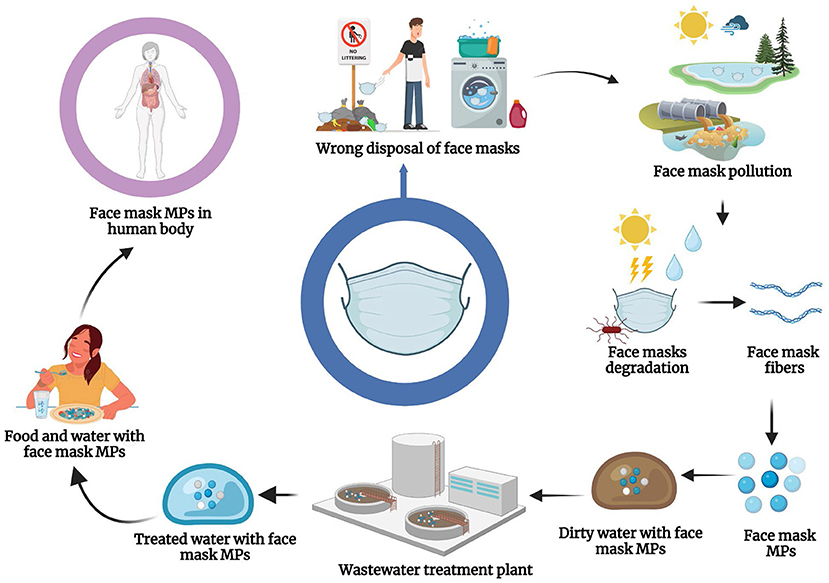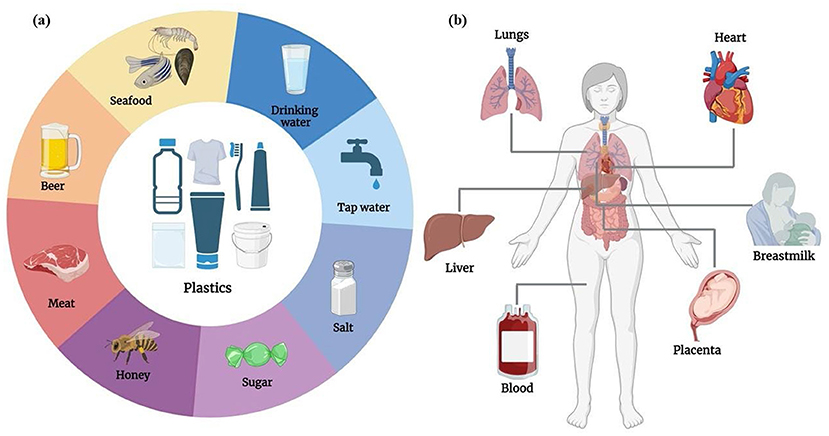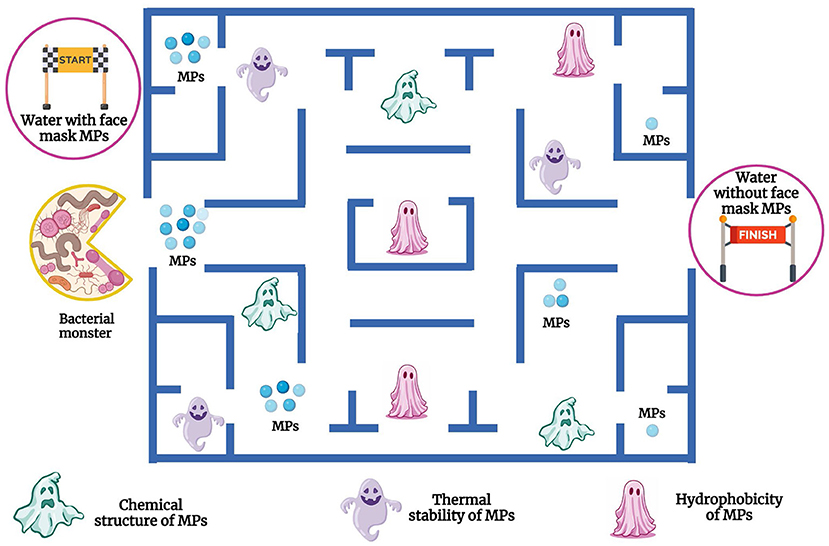Abstract
The use of face masks during the COVID-19 pandemic prevented many people from catching the virus, but it also produced a lot of environmental pollution from microplastics—small pieces of plastic the size of an ant or smaller. Microplastics travel for months through rivers, lakes, and drainage systems, until they reach wastewater treatment plants where contaminants are removed from water. However, due to their unique characteristics and small size, microplastics are not eliminated from treated water and can end up in our food. Luckily, tiny organisms like bacteria can help us to tackle this problem by “eating” microplastics. In this article, you will learn about these small creatures and how they can help us remove plastics from water.
Microplastics—How Little is “Micro”?
For decades, humans have used plastics in many types of products, including food containers, clothes, toys, tools, and home supplies. The first plastic was made in the 1950s. That is when plastic pollution began. Plastics can be broken down into very small pieces in the environment. Microplastics are pieces of plastic that range from about 1 micron in size (the size of a speck of dust) up to 5 millimeters (almost the size of an ant). Sometimes microplastics are so small that we need special instruments such as microscopes to see them. Microplastic pollution is one of the main environmental problems of our time, due to the small size and unique chemical characteristics of plastics. Back in the 1970s, scientists began to realize that plastics stuck around in the environment. Today, especially after the COVID-19 pandemic, the amount of microplastics in rivers, oceans, lakes, and wastewater has increased, likely due in part to the use of face masks.
Face Masks and Microplastics—An Alarming Environmental Problem
During the COVID-19 pandemic, three-layer face masks made of plastic materials were used to keep people from contracting the SARS-CoV-2 virus that causes the disease. The global production of masks increased dramatically—around 129 billion face masks were produced monthly [1], which is equivalent to the weight of two commercial airplanes. At the time, no one told us how these materials affect our environment and human health. Typically, we threw face masks away in the trash can, or in some cases people threw them in the streets, contaminating the environment (Figure 1). Approximately 10 million face masks entered the environment through inappropriate disposal practices, equivalent to the weight of seven tractors!

- Figure 1 - Microplastics (MPs) from face mask can get into the environment through improper disposal or washing.
- When the face masks degrade, microplastics end up in the water supply. Wastewater treatment plants cannot fully remove contaminating microplastics, so they are released with the treated water. Microplastics can then end up in our foods and our bodies.
The face masks that we threw in the trash can or on the streets traveled many kilometers to oceans, rivers, or lakes, dragged there by the wind or by rainwater drainage. During their journey of many days or even months, sun rays, and strong winds caused the masks to decompose, forming plastic fibers. The degradation process is much stronger when masks or plastic fibers reach water bodies because of water movement, the sun’s rays, and the strong winds further break them down into microplastics (Figure 1).
Due to the high demand for face masks, many people used them multiple times, sometimes washing and drying them before using them again. When face masks were washed, the shaking of the washing machine removed the dirt, but it also allowed small plastic fibers to be released, which later became microplastics and ended up in wastewater (Figure 1). You might be wondering, “What is the problem with face masks releasing a few microplastics?”. Well, each face mask weighs between 3–4 grams [1], meaning that ~30–40 tons of microplastics were generated daily. This is almost the weight of six elephants! Microplastic pollution is a problem because not only are enormous quantities found in oceans, lakes, rivers, and wastewater, but it is extremely difficult to eliminate microplastics with current treatment methods.
Do Wastewater Treatment Plants Remove Microplastics?
Let us talk about the microplastics that end up in wastewater. When the small plastics reach the drains in our homes or storm drains on the roads, they mix with wastewater that contains various contaminants (e.g., dish soap, shampoo, oils, and vegetable waste from our kitchens). Wastewater is transferred to wastewater treatment plants (WWTPs) where it is treated through many physical, chemical, and biological processes.
How do WWTPs work? Imagine that treatment plants are a train, and each step in the process is a train car. Wastewater enters and passes through the first train car, where solids or large materials are eliminated through filtering or settling to the bottom. In the second train car, some of the contaminants are removed by microorganisms, mainly bacteria. In the third train car, the remaining contaminants and leftover microorganisms from the second train car are eliminated through additional processes, including disinfection. Finally, in the fourth train car, the wastewater is free of major contaminants but still contains microplastics because WWTPs cannot typically remove all of those substances.
But wait a second, what is treated water used for? Well, we use it to irrigate green areas, to produce grain for farm animals to eat, and it is used in some industrial processes. Additionally, a large percentage of treated water containing microplastics is released into rivers, lakes, and oceans.
Microplastics Face Masks in Our Foods and Bodies
In the environment, microplastics are eaten by fish, shrimp, or oysters. For example, in 2022 in Songkhla Lake, Thailand, scientists found around 170 microplastic particles in the intestines of each fish and shrimp examined [2]! This is approximately three times more than the number found in fish and shrimp before the COVID-19 pandemic. If humans drink water or eat food contaminated with microplastics, microplastics can accumulate in our bodies and potentially make us sick. So far, microplastics have been found in salt, seafood, drinking water, meat, sugar, honey, and beer (Figure 2A). Scientists have found microplastics in the human body, for instance in the lungs, blood, breast milk, liver, saliva, and heart (Figure 2B) [2]. Scientists calculated that, before the pandemic, humans consumed around 322 micrograms of microplastics per year. After the pandemic, if we infer that the amount of microplastics we consume per year has tripled, by the end of 2024 we will have consumed around 966 micrograms—like eating a plastic marble toy!

- Figure 2 - (A) Foods and (B) human organs in which microplastics have been found.
Bacteria as Microplastic Degraders
Most of the processes that can degrade microplastics in water use chemicals that also contaminate water. Bacterial biodegradation is an excellent option for eliminating contaminants such as microplastics from water because bacteria are naturally present almost everywhere, such as in WWTPs [3].
Bacteria are microorganisms a few micrometers in size, and most live in soil or water. Bacteria feed on chemicals found in the environment that mainly contain carbon and nitrogen. Some bacteria can also consume certain pollutants and convert them into substances that are less dangerous for the environment. In the microplastic biodegradation process, bacteria in wastewater stick to the surface of microplastics through glue like substances produced by the bacteria. Then, bacteria act like little monsters (Figure 3) that slowly attack the chemical bonds of microplastics through the production and release of molecules called enzymes that speed up chemical reactions. Bacterial enzymes act like scissors, cutting the long microplastic molecules (which contain carbon atoms) into smaller molecules. Thus, bacteria can use microplastics as sources of nutrients and energy [3].

- Figure 3 - In bacterial biodegradation of microplastics (MPs), bacteria act like little monsters trying to destroy microplastic particles.
- However, these monsters face three main foes in this task (shown here as ghosts): microplastics’ chemical structure, thermal stability, and hydrophobicity. The stronger these foes, the more difficult it is for bacterial enzymes to degrade the microplastics. At the end of the labyrinth water without microplastic will be obtained.
However, the bacteria monster must dodge three foes to biodegrade microplastics: (1) plastics with very hard connections between molecules and atoms that are difficult to break down; (2) the capacity of microplastics to repel water, which is called hydrophobicity; and (3) the ability of microplastics to withstand high temperatures, which is called thermal stability (Figure 3) [4]. The stronger the connections and higher the thermal stability microplastic has, the more powerful the bacterial enzyme needs to be for bacteria to degrade it, and a longer biodegradation time is also necessary. Likewise, high hydrophobicity prevents bacteria from sticking to the microplastic, and degradation does not happen. The good news is that most microplastics arriving at WWTPs have lower hydrophobicity due to being exposed to sun or wind, thus bacteria can degrade them.
Take-Home Lessons
To minimize the environmental and public health problems caused by microplastics, we must urgently find a way to eliminate them. After the intensive use of face masks during the COVID-19 pandemic, the amount of microplastics in wastewater tripled. This is a big problem because WWTPs only manage to remove about 40% of microplastics. The remaining 60% ends up in water sources (e.g., lakes and rivers), which are used, for example, to irrigate crops and produce drinking water. Bacterial biodegradation is a promising process for breaking down or removing microplastics from wastewater—not only microplastics from masks, but from many other plastic products like clothes, sneakers, toys, and household products. Bacteria and other microorganisms present in WWTPs can degrade different types of microplastics, but to truly eliminate microplastics more research is needed to understand how we can help these organisms to help us clean our water.
Glossary
Microplastics: ↑ Microplastics are pieces of plastics that range from about 1 micron in size (the size of a speck of dust) up to 5 milimeters (almost the size of an ant).
Wastewater: ↑ Dirty water from homes or businesses.
Degradation: ↑ Breakdown of materials caused by their interaction with the environment.
Wastewater Treatment Plants: ↑ Services that clean dirty water from homes, businesses, and storm drains by removing harmful substances and pollutants, making it safe to reuse or release back into nature.
Bacterial Biodegradation: ↑ Process by which bacteria break down complex compounds into simpler compounds.
Enzymes: ↑ Molecules that speed up the rates of chemical reactions.
Hydrophobicity: ↑ Ability to chase away water.
Thermal Stability: ↑ Ability to resist a physical change as its temperature changes.
Conflict of Interest
The authors declare that the research was conducted in the absence of any commercial or financial relationships that could be construed as a potential conflict of interest.
Acknowledgments
AF-D acknowledges CONAHCYT for her doctoral scholarship (931191). All the figures were created with BioRender.com.
References
[1] ↑ Fadare, O. O., and Okoffo, E. D. 2020. Covid-19 face masks: a potential source of microplastic fibers in the environment. Sci. Total Environ. 737:140279. doi: 10.1016/j.scitotenv.2020.140279
[2] ↑ Haque, F., and Fan, C. 2022. Prospect of microplastic pollution control under the “New normal” concept beyond COVID-19 pandemic. J. Clean Prod. 367:133027. doi: 10.1016/j.jclepro.2022.133027
[3] ↑ Miri, S., Saini, R., Davoodi, S. M., Pulicharla, R., Brar, S. K., and Magdouli, S. 2022. Biodegradation of microplastics: better late than never. Chemosphere. 286:131670. doi: 10.1016/j.chemosphere.2021.131670
[4] ↑ Thakur, B., Singh, J., Singh, J., Angmo, D., and Vig, A. P. 2023. Biodegradation of different types of microplastics: molecular mechanism and degradation efficiency. Sci. Total Environ. 877:162912. doi: 10.1016/j.scitotenv.2023.162912
